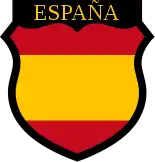Blue Legion
The Blue Legion (Spanish: Legión Azul; German: Blaue Legion), officially called the Spanish Volunteer Legion (Spanish: Legión Española de Voluntarios; German: Spanische-Freiwilligen Legion), was a volunteer legion created from 2,133 falangist volunteers who remained behind at the Eastern Front after most of the Spanish Blue Division was withdrawn in October 1943 because Francisco Franco had started negotiations with the Allies. It officially consisted of two battalions. It was later estimated that the legion grew to over 3,000 Spaniards.
| Spanish Volunteer Legion | |
|---|---|
 Insignia of the Blue Legion, incorporating the flag of Spain | |
| Active | 17 November 1943 – 12 April 1944 |
| Country | |
| Allegiance | |
| Branch | |
| Type | Infantry |
| Size | 2,269 troops |
| Nickname(s) | Blue Legion |
| Commanders | |
| Notable commanders | Antonio García Navarro |
A certain number of Spanish volunteers refused to return to Spain and remained on the Eastern Front, integrated into different German units. Some of them would continue to fight until the end of World War II. The 101st SS Spanish Volunteer Company (German: Spanische-Freiwilligen Kompanie der SS 101) of 140 men, composed of four rifle platoons and one staff platoon, was attached to the 28th SS Volunteer Grenadier Division Wallonien (the Walloon Legion) and fought against the Soviets in Pomerania and Brandenburg.[1]
The troops bore the word ESPAÑA and a red/yellow/yellow/red horizontally striped shield worn on the upper right arm, and a helmet.
References
- Julio, Rodriguez-Puértolas (2008). Historia de la literatura fascista española. p. 712.